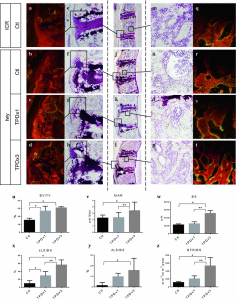Teriparatide Improves Trabecular Osteoporosis but Simultaneously Promotes Ankylosis of the Spine in the Twy Mouse Model for Diffuse Idiopathic Skeletal Hyperostosis.
Full study->teriparitadeboneformation
“Diffuse idiopathic skeletal hyperostosis (DISH) is a common skeletal disorder in the elderly, which can develop into periosteal hyperostosis and paradoxically into immobilization-associated trabecular osteoporosis. The bone anabolic agent, teriparatide (TPD), seems to be a rational treatment for the immobilization-associated osteoporosis. However, it can lead to development of hyperostosis lesions in DISH patients. Here, we demonstrate TPD effectively treats trabecular osteoporosis while simultaneously promoting ankylosis of the spine in DISH model tiptoe-walking Yoshimura (twy) mice, compared with the ICR mice. Eighteen male twy mice were divided into three groups, and ICR mice were used as a normal control. Subcutaneous injections of TPD or phosphate-buffered saline (PBS) were performed according to three dosing regimens; 40 µg/kg once daily (TPD × 1 group), 40 µg/kg three times daily (TPD × 3 group), and PBS (control; Ctl group). Treatment was commenced at the age of 7 weeks and continued for 5 weeks. Micro-computed tomography (µCT) and histological analysis were performed. Longitudinal µCT study revealed that trabecular bone volume in both the vertebral body and distal femur decreased with time in the Ctl group, but increased dramatically in the TPD × 3 group. The twy mice developed ankylosis of the spine, the progression of which was accelerated with TPD therapy. We also confirmed that TPD therapy promoted ossification of spinal ligaments. Histomorphometrical study revealed that TPD treatment increased bone formation at the vertebrae enthesis region{This is the key to where this has promise} and in the trabecular bone. TPD therapy effectively treats trabecular osteoporosis, but potentially promotes ankylosis of the spine in patients with DISH.”
“The twy mice are mutant mice showing multiple osteochondral lesions, and have been used as a model for DISH and ossification of the posterior longitudinal ligament”
Teriparatide increased ectopic calcification(Fig3C).
“both TPD × 1 and TPD × 3 treatments promoted ectopic calcification. Histologically, there were no cells inside the ectopic calcification but there were fibroblast- or osteoblast-like cells around the ectopic calcification.”<-Fibroblast cells could be precursors to chondrogenic cells.
Here you can see the effects of teraparatide, it can increase height of the spine but also can cause scoliosis:

